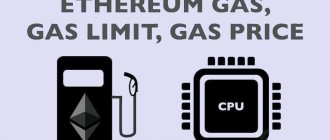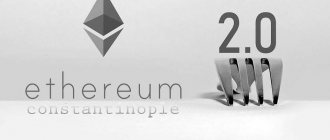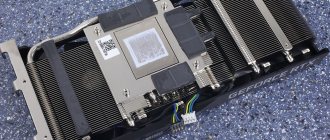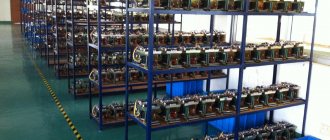If you want to start mining Vitalik Buterin’s cryptocurrency, you should first familiarize yourself with the concepts of difficulty and hashrate of the Ethereum network. Without this, choosing the optimal equipment for mining ether coins and determining its potential profitability will not be possible.
This knowledge will also help you understand how the current model of the Ethereum blockchain is supported and why developers want to change it.
- What is the Ethereum network hashrate?
- Dynamics of Ethereum hashrate changes
- Understanding the complexity of the Ethereum network
- Relationship between hashrate and Ethereum network difficulty
- Factors affecting the hashrate and complexity of the Ethereum network
- Analysis of Ethereum Difficulty Changes
What is the Ethereum network hashrate?
Ethereum hashrate
(English hash rate, rate of hashing) is an indicator that reflects the speed of solving mathematical problems (hashes) that ensure the generation of new blocks in blockchain networks based on the PoW (Proof-of-Work) algorithm.
When we talk about the hashrate of the Ethereum network, we mean the total computing power of the mining equipment connected to this network.
Ethereum hashrate, like any other blockchain network, is measured in hashes per second (H/s). But, in order to avoid the use of an excessive number of zeros at the current stage of development of computing power, the hash rate of the Ethereum cryptocurrency is expressed in Gigahashes (1 GH/s = 1000000000 H/s) or Terahashes per second (1 TH/s = 1000000000000 H/s).
The current Ethereum hashrate fluctuates around 150 TH/s and is formed by all GPU/ASIC devices connected to the Ethereum network, the power of which is usually combined through mining pools.
You can view the history of Ethereum hashrate changes on the website of the blockchain browser Etherscan or the cryptocurrency statistics service Bitinfocharts.
Ethereum hashrate chart (April 2019)
// Source: Etherscan.io
ETH hash: how to find out the indicator?
To track the dynamic indicator, special resources are used. For example:
- https://etherscan.io/chart/hashrate - hashrate chart for all time, with the ability to select the period of interest for detailed study. In addition to growth dynamics, the service informs about the maximum and minimum hashrate indicators for the entire history of Ethereum. Displayed in GH/second.
- https://bitinfocharts.com/ru/comparison/ethereum-hashrate.html - an alternative option for tracking the average hashrate per day. Indicators are displayed in TH/second without the ability to select the time period of interest for detailed study.
- https://2miners.com/ru/eth-network-difficulty is a convenient service that allows you to monitor several indicators of the Ethereum network at once. For example, the “Ethereum hashrate now” tab allows you to find out the network hashrate at the moment. There are also charts (ETH hashrate chart) that can be used to track the dynamics of the indicator in different time periods.
Dynamics of Ethereum hashrate changes
During the first month since the launch of Ethereum (July 30, 2015), the hashrate increased from 11 to 360 GH/s. With such indicators, only a thousand video cards of average performance GTX models operating in solo mining mode were sufficient to support the operation of the ether and the extraction of new blocks.
Until the end of March 2016, the Ethereum hashrate slowly grew 2.5 times (900 GH/s). Then the growth accelerates significantly: by the end of July, the hashing rate increases 5-fold (up to 4.6 TH/s). Then there is a decrease to 3.6 TH/s due to the branching of the network on Ethereum Classic and Ethereum.
At the end of October, the hashrate reaches its 2016 maximum (7.9 TH/s) and then halves within 10 days (to 3.9 TH/s). The reason for this was the transition of a significant number of miners to the Zcash anonymous cryptocurrency network launched on October 28.
Ethereum hashrate chart (2015-2016)
// Source: Etherscan.io
Recovery takes several months, but already in mid-January 2017, the hash rate again reaches the level of 7.9 TH/s, after which stable growth continues.
Throughout 2022, Ethereum hashrate continues to grow at a rate that accelerates every few months. At the end of May, the hashrate increases 4.5 times (36 TH/s) compared to January. Until the end of the year, even more rapid growth is observed to 155 TH/s.
The reason for such a significant increase in the network’s computing power is considered to be the growing popularity of Ethereum, the second largest cryptocurrency by capitalization at that time, the blockchain of which became the basis for many projects. Also, an important role was played by the global bull market set by Bitcoin and which brought the ether price to $1,350 in mid-January 2018.
After this, the growth of the hash rate by inertia continues for about 7 months, coming very close to the level of 300 TH/s in the middle of last year.
Since August 2018, the Ethereum hashrate has been steadily falling (with small rebounds) and is currently 1.73 times lower than last year’s April indicators (150 TH/s versus 260 TH/s).
Ethereum hashrate chart (2017-2019)
// Source: Etherscan.io
This is explained by the disconnection of participants from the network due to the unprofitability of mining ether, the price of which once again went to look for a new bottom.
Also, an important role was played by the news about the plans of Ethereum developers to once again reduce the reward for miners and preparations for transferring the network to PoS (Proof-of-Stake, proof of ownership).
We also recommend watching our video about what will happen with Ethereum mining:
Ethereum Mining Forecast
What does it depend on
Hashrate depends on a lot of factors. First of all, it depends on the network hashing algorithm. Some video cards show excellent efficiency when mining Bitcoin, since they are adapted for SHA-256, but are absolutely unprofitable for mining ETH coins. This is due to the fact that these cryptocurrencies have different hashing algorithms.
Hardware specifications are another very important point, but this applies to a greater extent to video cards, the power of which varies depending on the manufacturer. AMD does not directly create graphics devices, but purchases them from suppliers.
Therefore, the same model can function differently.
We must not forget about the popularity of cryptocurrency. The higher it is, the more users are engaged in mining. They connect their farms, thereby increasing the network hashrate. Naturally, mining has become more difficult as the difficulty of ether is also increasing. These are the key factors on which such an important indicator depends. They need to be taken into account.
Understanding the complexity of the Ethereum network
Ethereum difficulty is a dynamic indicator that displays the number of computational operations (hashes) that must be performed to find a new block and receive a reward.
The difficulty level changes after a certain number of new blocks are mined based on an analysis of the network. This is done to prevent a significant acceleration or slowdown in the production of new ether coins.
In addition, the developers introduced the so-called “difficulty bomb” into the Ethereum protocol - an algorithm for exponentially complicating the mining of new coins, which at a certain point will make mining virtually impossible and extremely unprofitable. Theoretically, this mechanism should ensure a painless transfer of ether from the PoW algorithm to PoS.
Taking into account the relationship between difficulty and network hashrate, miners determine the energy efficiency and profitability of the devices they use to mine Ethereum.
Subtleties of calculation
The task of the algorithm of any cryptocurrency network is to self-regulate, this also applies to the time of creation of new blocks.
For Ethereum, the figure is approximately 15 seconds. To ensure that the time for adding new blocks does not decrease with increasing computing power, the complexity of the network changes. It is calculated in hashes and shows the number of operations required to find the Nonce parameter. To calculate the network hashrate, it is enough to divide the difficulty by the average block formation speed. Moreover, time is a relatively stable parameter, while the other two change directly proportionally.
Relationship between hashrate and Ethereum network difficulty
Ethereum Blockchain
The complexity of the network is directly related to the hashrate and the time it takes to find a block. The more participants in the network, the higher its total computing power and the faster new blocks are generated. However, a significant acceleration in the production of new coins is not allowed by increasing the difficulty. This ensures control over the rate of emission and inflation of Ethereum.
In the opposite situation, when, for example, due to a serious decrease in the cost of ether, mining becomes unprofitable, some network participants are disconnected, which leads to a drop in the hashrate and a slowdown in the speed of finding new blocks. At the same time, the difficulty is proportionally reduced, which allows the remaining miners to receive more income, motivating them to continue supporting the work of Ethereum.
How is it calculated
The miner receives a huge amount of raw information. It uses hash farms to divide data into small blocks in which transaction information is recorded. The correct values are selected by solving complex cryptographic problems. This process largely depends on which hashing algorithm is used. If we are talking about Ethereum, then this project is based on Ethash.
The speed of selecting values depends on the hashrate. The fastest way to find a block is to use ASICs. The peculiarity of this equipment is that it was originally created for mining. Modern video cards and ASIC miners are capable of sorting through hundreds of thousands and even millions of hashes. To avoid confusion, it was decided to use special units for measuring the speed of this process:
- kH – 1000 h/s;
- MH – 1,000,000 h/s;
- GH – 1,000,000,000 h/s;
- NH – 1,000,000,000,000 h/s;
- PH – 1,000,000,000,000,000 h/s.
Factors affecting the hashrate and complexity of the Ethereum network
Since difficulty and Ethereum hashrate are inextricably linked, they are largely influenced by the same factors:
- the number of mining equipment connected to the network;
- changing the mining algorithm, in particular the time to mine a new block and the reward for finding it;
- the cost of electricity and the Ethereum rate (affects profitability and the number of miners);
- improvement of technology (leads to an increase in the power of the equipment used by miners);
- level of popularity of ether in the crypto community (mainly depends on the global trend of the cryptocurrency market, affects the number of miners).
Ether: hashrate - in what context is this term still used?
When considering the term hashrate, it is worth considering how it applies to hardware. Each device involved in the mining of Ethereum coins has an individual performance. For example, the Bitmain AntMiner E3 ASIC produces 190 MH/s, AMD Radeon R9 series GPUs - from 20 to 30 MH/s, NVIDIA GeForce GTX GPUs of various models - from 10 to 35 MH/s, and so on. The greater the power of the farm used, the greater the potential earnings of the miner.
You can find a comparison table of GPUs by hashate in the article: “Top of the best video cards for cryptocurrency mining 2021.”
Why is the video card hashrate shown differently?
ASIC is the most powerful mining hardware. Manufacturers create integrated circuits from uniform drawings. Of course, components are supplied by different dealers, but all ASIC miners are unified. They are identical in performance. With video cards everything is much more complicated. AMD and NVIDIA companies supply graphics chips, and third-party organizations develop the final product - video cards.
As an example, consider the R9 model. It is sold in several variations from different manufacturers: ASUS, SAPHIRE, etc. In addition to the key computing module, other components also affect the speed of hash enumeration. In particular, the memory chip. The most powerful manufacturer is Samsung. If the video card has a Hynix chip, then its performance drops. As a result, the R9 graphics card has different power levels, which depend on the configuration. The difference can be several MH.
Problems often arise with checking the memory type. For in-depth testing, you need to connect the equipment to the PC and run the software. Manufacturers indicate the power of the video card for each algorithm. But these are approximate numbers. In practice, we get completely different values.
Hashrate increase
Firstly, you don’t need to overclock your equipment right out of the box. First, the farm should operate as usual.
When increasing power, the equipment always heats up more and consumes more resources, so the increase in performance must be weighed.
Typically, a card manufacturer supplies equipment in such a way that a few tens of percent can still be squeezed out of it.
When overclocking, you risk burning out your video cards. Therefore, you need to work to increase hashrate in compliance with the following principles:
- gradual acceleration,
- conducting stress tests (look for aida64 stress test),
- check in action.
The easiest way is to tweak the settings in MSI Afterburner.
For Nvidia and Ethereum mining, do the same with the OhGodAnETHlargementPill utility running.
Reduce voltage to the minimum possible. Gradually move the Power Limit a few percent at a time, accepting the changes. Then Core Clock in 50 MHz steps. Also embrace change.
Each card has its own indicators, so it is wiser to search for information on the Internet for a specific model. For example, for 1080 one miner found the following settings:
After this, a stress test is carried out. And so on until the driver is reset after the stress test. Then from these indicators we return to the previous stable indicators and leave them.
Then it is recommended to test the video cards in high-demand games for about 1-2 hours.
The best and worst Nvidia GTX 1660 Super models
Nowadays, all cards have almost the same hashrate; we mostly come across cards with Hynix . In mining, the operating temperature of the card is also important. 3daynews conducted a temperature test of the 1660 Super line of cards - here are the results:
Temperature operating conditions of Nvidia GTX 1660 Super according to 3daynews.
Based on this test result, you can evaluate the cooling quality of a 1660 super card from a specific vendor and model. From personal experience I can say that the most problem-free cards were from Palit and MSI . But cards from GIGABYTE , especially with 1 copper tube, got very hot, the cooler was turned to 100% in the summer and other cards in the rig were heated. If possible, buy models with 2 or 3 coolers. Carefully read the reviews on the retailer’s website - the CSN has sorting by stars and statistics of calls to the service department for each product. Also very useful information.











